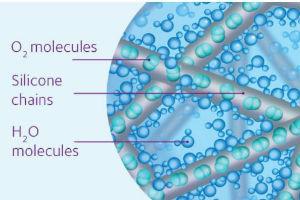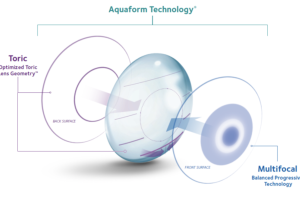
An aging population means increasing numbers of existing and emerging presbyopes need advice on how best to correct their vision with contact lenses. Consider too, that like the rest of the vision corrected population, around 40% of presbyopes may also have at least 0.75D of astigmatism,1 and the need for a reliable toric multifocal lens becomes clear. In fact, it is estimated one-third of toric contact lens wearers are of presbyopic age.2 Alternative methods of correction for this astigmatic presbyopic patient group all include compromise, such as adding reading spectacles to toric distance contact lenses, wearing monovision contact lenses, continuing in spectacles full time or, for low astigmats, best sphere only correction of their distance refraction.
Numerous factors contribute to successful contact lens wear, but dissatisfaction with visual performance is particularly related to drop out for both toric and multifocal CL wearers.3-5 This demonstrates the importance of being able to recommend contact lenses designed to address both of these vision correction needs. Furthermore, age-related changes are known to degrade the tear film,6,7 making the choice of contact lens material an additional important consideration for presbyopes to help maximize their lens comfort.
Combining Proven Technologies
Biofinity® toric multifocal is comprised of a unique combination of technologies, bringing together proven features already available in the Biofinity® portfolio, into one lens designed to meet the needs of patients outlined above. The lenses are manufactured using the same SiHy material (comfilcon A) used in all Biofinity® lenses, using the same high precision and repeatable manufacturing process as Biofinity® XR toric lenses.
Lens Features
Designed for a reliable fit, Optimized Toric Lens Geometry™ lenses incorporate a unique back surface curvature to minimise on-eye movement and rotation, and support stable lens positioning. Designed for exceptional vision, Balanced Progressive® Technology is optimised for each sphere and add power, with two distinct optical designs providing the choice of centre distance (D) or centre near (N) lenses. Aquaform® Technology, common to all Biofinity® lenses, allows for naturally wettable SiHy materials without the need for surface treatment. Biofinity® toric multifocal is available in a wide range of sphere, cylinder, and add powers, with axes in 5⁰ steps. This range delivers over 200,000 unique prescription options,8 and correction for 99.6% of astigmatic presbyopes.9
Clinical Performance
So how well does the lens perform for patients? In clinical studies Biofinity® toric multifocal shows high levels of success in terms of lens fit, rotational stability, orientation position and subjective vision performance. Excellent or acceptable vision performance was achieved at initial lens fitting in more than nine out of ten patients,10 and orientation and rotational stability on settling was equivalent to that with Biofinity® toric.11 High levels of comfort were found with Biofinity® toric multifocal, and in terms of overall preference, patients chose Biofinity® toric multifocal over Proclear® multifocal toric by a ratio of more than 3:1.10
Tips For Success
Patient selection
There are significant numbers of patients who may benefit from wearing a toric multifocal contact lens. This ranges from those currently wearing a toric lens who become presbyopic; astigmatic presbyopes who have never worn contact lenses before and find glasses inconvenient, through to patients who may require a spherical multifocal in one eye and a toric multifocal in the other.
Fitting support
Achieving reliable, accurate and quick fits in practice is crucial to the success of any contact lens. Accurate trial lens selection is important for successful soft toric fitting, and multifocal lens success is enhanced by using the manufacturers’ recommended fitting guides. The OptiExpert® tool, available online and as an app, manages both of these considerations. The OptiExpert® tool helps with initial lens selection, and an updated version combines the toric and multifocal calculators to help select the initial Biofinity® toric multifocal lens.
Conclusion
The demand to accurately correct the vision of astigmatic presbyopes in contact lenses is growing. With its extensive range of prescriptions, Biofinity® toric multifocal has been designed to meet a growing need for patients as their vision changes. Biofinity® toric multifocal can give confidence to prescribing eye care professionals that the lens can be fit accurately and successfully, performing well for patients in terms of vision and comfort.
References
1. Luensmann D, Schaeffer JL, Rumney NJ, et al. Spectacle prescriptions review to determine prevalence of ametropia and coverage of frequent replacement soft toric contact lenses. Contact Lens and Anterior Eye 2018;41.
2. Industry fit data. January 2017-December 2017 Italy, UK and Germany. 41% of toric CL wearers age 41 years or over.
3. Sulley A, Young G, Hunt C, et al. Retention Rates in New Contact Lens Wearers. Eye & contact lens 2018;44 Suppl 1:S273-S82.
4. Young G, Veys J, Pritchard N, et al. A multi-centre study of lapsed contact lens wearers. Ophthalmic & physiological optics : the journal of the British College of Ophthalmic Opticians 2002;22:516-27.
5. Young G. Why one million contact lens wearers dropped out. Contact lens & anterior eye 2004;27:83-5.
6. Patel S, Boyd KE, Burns J. Age, stability of the precorneal tear film and the refractive index of tears. Contact lens & anterior eye 2000;23:44-7.
7. du Toit R, Situ P, Simpson T, et al. The effects of six months of contact lens wear on the tear film, ocular surfaces, and symptoms of presbyopes. Optometry and vision science 2001;78:455-62.
8. CVI data on file 2019. Based on total number of prescription option combinations manufactured (for sphere, cylinder, axis, and add—including D & N combinations).
9. CVI data on file 2020. Rx coverage database; 14 to 70 years.
10. CVI data on file 2018. Non-dispensing, subject masked, randomized, bilateral, cross-over short-term evaluation. 27 subjects at 2 sites (UK and US) fitted using CVI fit guide.
11. CVI data on file 2019. Sub-analysis of lens stability on settling with BT & BTMF. N=89.








